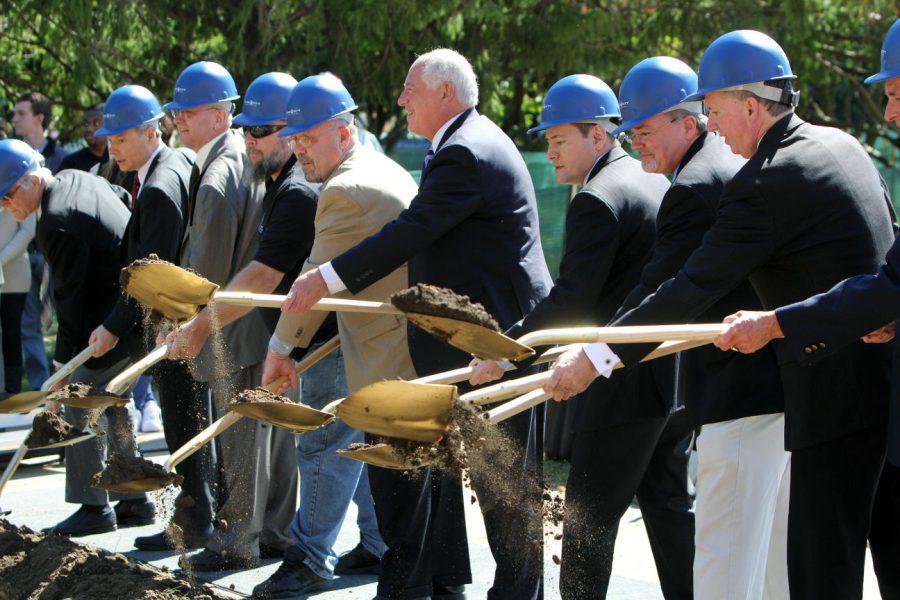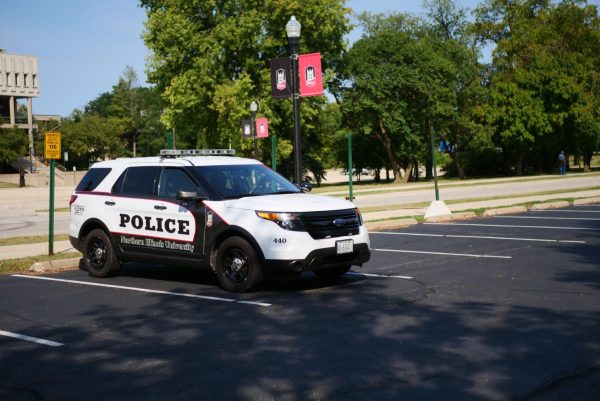$27M Stevens Building construction kicks off
Gov. Pat Quinn (without hard hat), flanked by DeKalb Mayor John Rey on his left and John Butler, Board of Trustees chair, on his right, shovels dirt during the Stevens Building groundbreaking Monday. The building was demolished in the summer. Its 109,000-square-foot replacement will feature a 330-seat lecture hall and Black Box Theatre.
September 23, 2014
Gov. Pat Quinn, along with contractors, administration, faculty and students, broke ground on a $27.4 million project to reconstruct the Stevens Building Monday.
John Butler, Board of Trustees chair, said the construction would be especially important for people in the theater and dance arenas, as well as the Anthropology Department. Construction began in May with the demolition of a 27,200-square-foot wing in July. After the groundbreaking ceremony Monday, contractors will begin work on the building, which will include the Black Box Theatre with supporting scene shop as well as a 330-seat lecture hall.
The remainder of the building will be rehabilitated. The whole building will be an about 109,000 total square feet.
Quinn said the project was a huge investment by the state, but the result would pay dividends for the next century, especially for the arts, which Quinn said “stir the soul,” and anthropology.
“This university is an economic magnet,” Quinn said. “Not just for DeKalb Country or Northern Illinois, it’s really for our whole state.”
On Jan. 27, 2010, Quinn released $10.3 million for construction projects, which went to re-purposing Cole Hall and the Stevens Building, according to an NIU news release. The funding was provided by the Capital Development Board, which has allocated more than $3.4 billion in state grants for construction in schools.
Bill Nicklas, vice president of Operations and Community Relations, said there is a lot of work the university could be doing on other buildings, but agreed with Quinn that “the arts really stir the drink.”
“First of all, [Stevens Building] had its own issues,” Nicklas said. “It was becoming more difficult to serve the needs of the students and the college certainly aspired to work on first-class stages and we weren’t able to provide the facilities.”
Those issues included outdated plumbing and electrical systems, failing heating and cooling and an unredeemable roof.
Rich Holly, College of Visual Arts and Performances dean, said the Stevens Building’s condition was brought to the state’s attention more than 20 years ago. The state agreed to fund the building, but went through a period where it did not fund any buildings, Holly said.
Holly said Stevens was never built as a professional training building for the arts, as numerous departments shared the building when it was first opened in 1959.
“Through the late 1960s and into the early 1970s, all of the arts programs on campus became what we call professional training programs,” Holly said. “Which means we have to have professional quality facilities … .”
The building is expected to be completed by October 2015.














